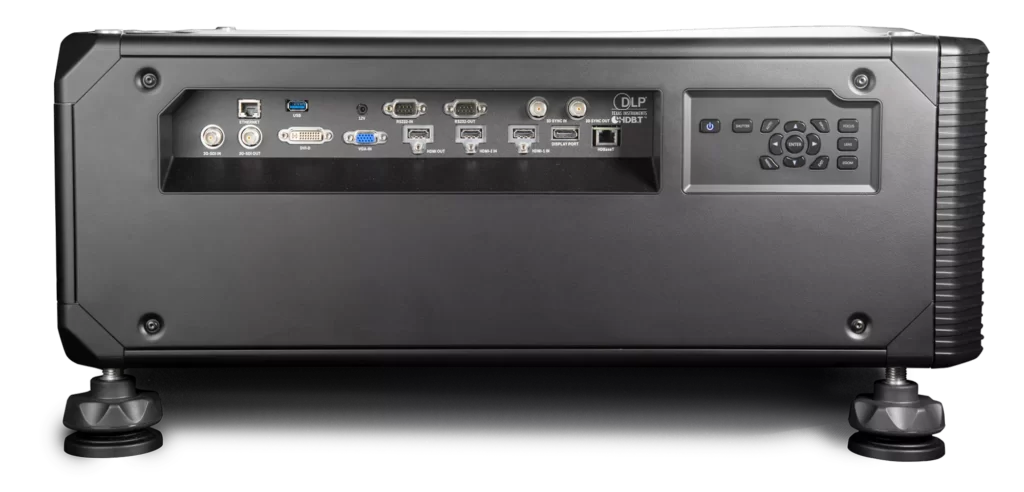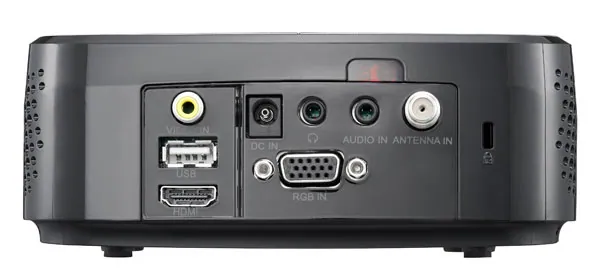In today’s digital era, projectors have become an essential tools for presentations, home theaters, and various other applications. They allow us to display images and videos on a large screen, enhancing the visual experience. While projectors are commonly known for their HDMI, VGA, and USB inputs, some users may wonder if projectors have coaxial (coax) inputs as well.
Here, In this article, we will explore the topic of projectors with coax input and also provide some tips on How to connect a coaxial cable to a projector, their benefits, and alternatives.
Coaxial Input?
Coaxial input, often referred to as coax input, is a type of connection used for transmitting audio and video signals. It utilizes a coaxial cable, which consists of a central conductor surrounded by insulation and a metallic shield.
Coaxial cables are widely used for television signals, cable TV, satellite TV, and other audiovisual applications. They provide a reliable and high-quality connection for transferring signals over long distances.
Evolution of Projectors
Projectors have come a long way since their inception. From bulky and expensive devices, they have transformed into compact and affordable multimedia powerhouses. Modern projectors offer an array of features, including high resolutions, vibrant colors, and advanced connectivity options.
These advancements have made projectors a viable alternative to traditional TVs, especially in home theater setups.
Do Projectors Have Coaxial Input Really?
Not all projectors come equipped with coaxial input. The availability of this feature varies depending on the projector model and brand. So, it is important to check the specifications of a projector before making a purchase if coaxial input is a requirement for your setup.

However, it is worth noting that most modern projectors prioritize digital inputs like HDMI and may not include coaxial input as a standard feature.
The Role of Coaxial Input in Projectors
Projectors with coaxial input provide users with the ability to directly connect their cable TV or antenna signals to the projector without the need for additional equipment or signal conversion.
This feature allows users to enjoy their favorite TV shows, sports events, and other cable or broadcast content on a larger screen, similar to a traditional television setup.
Advantages of Projectors with Coaxial Input

- Simplified Setup: Projectors with coaxial input eliminate the need for separate cable boxes or signal converters, streamlining the setup process. Users can connect their existing cable or antenna directly to the projector, saving both time and money.
- Space Optimization: Without the need for additional devices, projectors with coaxial input help reduce clutter and free up space in your entertainment area. This feature is particularly beneficial for those who prefer a minimalist setup or have limited space available.
- Versatile Entertainment: By connecting cable or antenna signals directly to the projector, users gain access to a wide range of content options. They can watch their favorite TV shows, live sports events, news, and other broadcast programs on a large projection screen, enhancing the overall viewing experience.
Limitations of Projectors with Coaxial Input
- Audio Output: While projectors with coaxial input enable video transmission, they may not always provide audio output. In such cases, users will need to connect an external audio system to the projector separately to ensure a complete audio-visual experience.
- Signal Quality: The quality of the coaxial signal can vary depending on factors such as cable length, signal strength, and interference. It is essential to use high-quality coaxial cables and ensure a strong and stable signal to avoid any degradation in audio or video quality.
- Limited Connectivity: Projectors with coaxial input often have limited additional input options. If you require multiple input sources or connectivity with other devices, it is crucial to check the projector’s specifications and ensure it meets your requirements.
Alternatives to Coaxial Input for Projectors
If you have a projector that lacks a coaxial input but still wants to connect it to a cable or satellite TV source, there are alternative solutions available. One option is to use an external TV tuner box. These devices can be connected to the projector’s available inputs, such as HDMI or VGA, and provide a way to tune in to cable TV channels.

Another option is to utilize a media streaming device that supports live TV streaming services, as many modern streaming devices offer access to cable channels through internet-based platforms.
These alternatives allow you to enjoy cable or satellite TV content on your projector, even without a dedicated coaxial input.
However, it’s important to note that they may require additional setup steps and equipment, which could introduce some complexity compared to projectors with built-in coaxial input.
Factors to Consider When Choosing a Projector
When selecting a projector, it is essential to consider several factors to ensure it meets your specific needs:

- Resolution: Choose a projector with a resolution that suits your viewing preferences and content requirements. Common resolutions include HD (1080p) and 4K.
- Brightness: Consider the brightness output of the projector, measured in lumens, to ensure optimal visibility in different lighting conditions.
- Contrast Ratio: A higher contrast ratio enhances the visual experience by providing a more distinct separation between dark and bright areas. This feature is particularly important for movies and other content with varying light levels.
- Connectivity Options: Apart from coaxial input, evaluate the availability of other inputs like HDMI, VGA, USB, and audio ports based on your intended usage.
- Throw Distance: Determine the throw distance required for your setup, considering the available space and desired screen size.
Best Projector Models with Coaxial Input

While projectors with coaxial input may be less common, there are a few models available in the market that cater to this requirement. Some popular options include LG HX350T XGA DLP Projector, LG – PF50KA 1080p, and Epson MovieMate 60. These models offer a range of features, including coaxial input, ensuring seamless integration with cable or satellite TV systems.
How to Connect a Coaxial Cable to a Projector: Step-by-Step Guide
Gather the Necessary Equipment
Before you begin, make sure you have the following equipment:
- Projector with a coaxial input
- Coaxial cable
- Cable or satellite TV receiver box
- HDMI cable (optional, depending on the projector)
To ensure a successful setup, follow these tips:
- Locate the coaxial input on the projector and connect the coaxial cable securely.
- Adjust the projector settings to the appropriate input source (e.g., coaxial input).
- Use the projector’s menu options to fine-tune the display settings, such as aspect ratio and image quality.
- Position the projector and screen properly, considering factors like distance, angle, and screen height for an optimal viewing experience.
Optional: Connect an HDMI Cable (If Supported)
If your projector has an HDMI input, and your cable or satellite TV receiver box supports HDMI output, you can achieve better video and audio quality by connecting an HDMI cable between the two devices.
Simply connect one end to the HDMI output on the receiver box and the other end to the HDMI input on the projector.
Test and Enjoy
With all the connections made and settings adjusted, it’s time to test your setup. Power on the cable, select a channel, and enjoy your favorite TV content on the big screen!
Jumbles & Confusions
- All projectors have coaxial input: This is not true. While some projectors offer coaxial input as a feature, it is not a standard inclusion in all projector models. Always check the specifications before making a purchase.
- Coaxial input guarantees superior quality: The quality of the audio and video output depends on various factors, including the quality of the coaxial cable, signal strength, and the projector’s capabilities. While coaxial input provides a convenient connection option, it does not guarantee superior quality on its own.
- Projectors with coaxial input are more expensive: The price of a projector depends on various factors such as brand, specifications, and additional features. The presence of coaxial input does not necessarily make a projector more expensive.
Recommended:
- Guide to Tell Green Wire Positive or Negative: (Steps & Examples)
- Projector Ports: What Are The Ports Available In A Projector?
- Different Projector Resolutions Explained
- 4K 30hz Vs 60hz: Which HDMI Should I Pick?
- Learn All About Projector Specs: An Ultimate Projector’s Guide!
Projector With Coax Input: FAQs

Can I connect cable TV to a projector with coaxial input?
Yes, projectors with coaxial input allow you to connect cable TV signals directly to the projector without the need for additional devices.
Are all projectors equipped with coaxial input?
No, coaxial input is not a standard inclusion in all projectors. It is essential to check the specifications of a projector before purchasing to ensure it has coaxial input if that is a required feature.
What are the other audio and video input options available in projectors?
Projectors commonly offer alternative input options such as HDMI, VGA, DVI, USB, and wireless connectivity. These options allow users to connect various devices and sources to the projector.
Can I use a coaxial-to-HDMI adapter with a projector?
Yes, it is possible to use a coaxial-to-HDMI adapter to connect a coaxial cable to a projector with HDMI input. However, it is important to ensure the compatibility of the adapter and the projector.
Are projectors with coaxial input more expensive than those without?
The price of a projector depends on various factors such as brand, specifications, and additional features. The presence of coaxial input does not necessarily make a projector more expensive. It is advisable to compare different models to find the one that best suits your budget and requirements.
Final Thoughts
We’ve reached the end of our article and hope, now you got sufficient info about
Projector with coax input. Yes, projectors with coaxial input offer an enticing option for home theater enthusiasts who want to integrate their cable TV experience with the immersive visuals of a projector.
While coaxial input may have some limitations, it provides a convenient and streamlined solution for enjoying cable TV shows and channels on a larger screen. With advancements in projector technology, users can now choose from a variety of projector models that offer coaxial input, ensuring a personalized and captivating viewing experience. Thank You For Reading!
As an experienced Software Engineer in a Projection-Based Technology Company, I love sharing my Knowledge to utilize and help others to learn more about Projectors. Thus one can get the right Projector for their needs.



